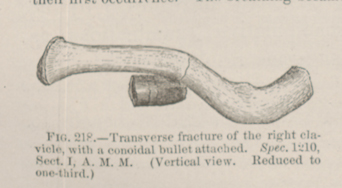Title: A——, Samuel
Source text: Surgeon General Joseph K. Barnes, United States Army, The Medical and Surgical History of the War of the Rebellion. (1861–65.), Part 1, Volume 2 (Washington, D.C.: Government Printing Office, 1870), 482.
Civil War Washington ID: med.d1e19325
TEI/XML: med.d1e19325.xml
CASE.—Sergeant Samuel A——, Co. F, 125th Pennsylvania Volunteers, aged 40 years, was wounded at Chancellorsville, Virginia, on May 3d, 1863, and was admitted to Carver Hospital, Washington, on the 9th. A bullet wound was found on the right side of the back, near the spine, and in the neighborhood of the third dorsal vertebra. There was a fracture of the clavicle on the same side, with considerable swelling, and some deformity of the shoulder. The patient had frequent cough, and bloody expectoration. The fracture of the clavicle was treated by a pad in the armpit and a sling, and the wound in the back was dressed with wet lint covered with oiled silk. Small doses of morphia were given, with the effect of diminishing very much the frequency of the cough. The patient was feeble, and the discharge from the wound considerable, but no very serious symptoms presented themselves until the 16th, when the patient was seized with considerable oppression of breathing, and with pain on the wounded side. Dullness over the upper side of the right lung was observed on percussion. A discharge of blood and serum from the wound seemed to relieve the pneumonic symptoms in a few hours after their first occurrence. The breathing became easier, and pain was no longer complained of. Bleeding from the wound ceased on the 17th, but a copious discharge of serous pus remained, and the patient became gradually weaker, notwithstanding the free use of stimulants and of as much nourishment as could be administered. His sinking was slow but constant, and he died on the afternoon of May 20th. At the autopsy, the bullet was found just below the clavicle, near its middle, having fractured the bone transversely after passing between the third and fourth ribs, and fracturing the neck of the third near its angle. The specimen figured in the adjoining cut (FIG. 218), was presented to the Army Medical Museum, with the above account, by Acting Assistant Surgeon B. F. Craig.
